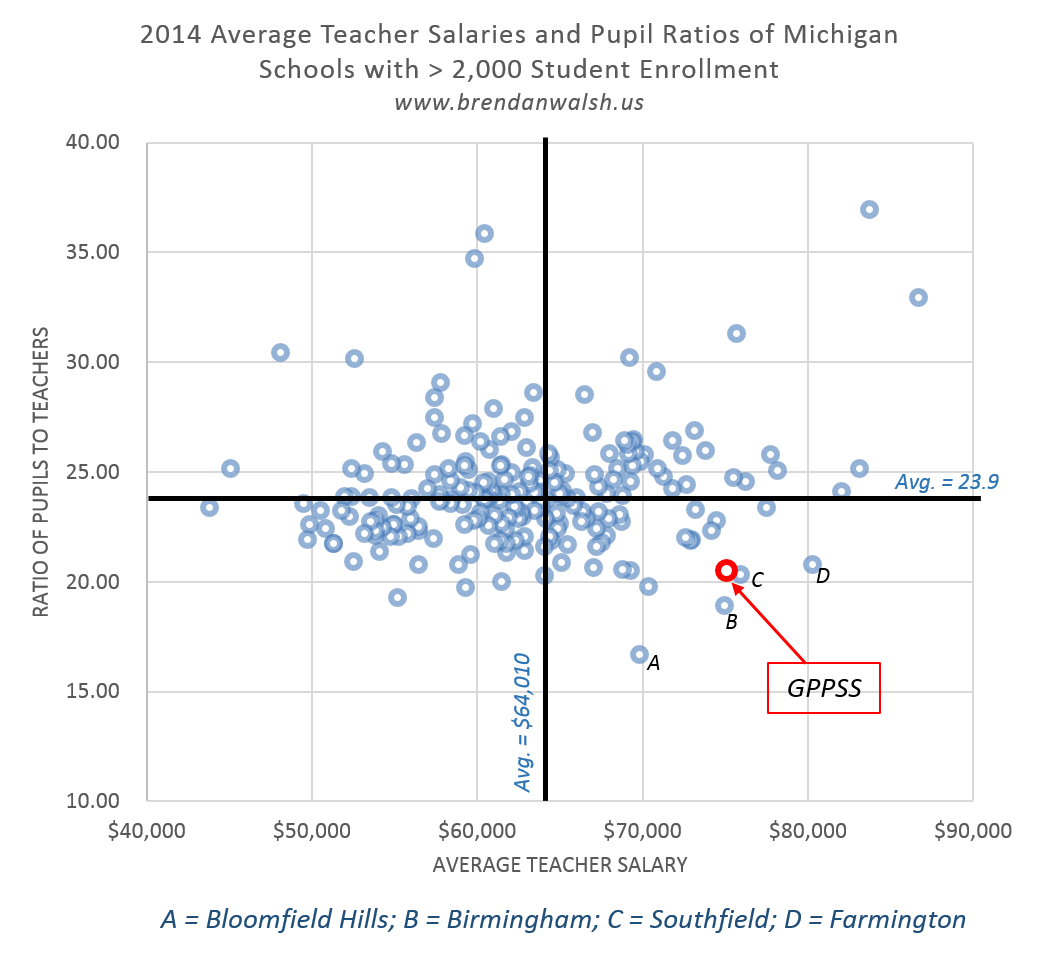Budget approval season is upon us for Michigan public schools and at least two – Farmington and Southfield – are learning how hard it is to maintain low class sizes, robust course offerings and pay higher than average teacher salaries – a topic I have treated before.
The Grosse Pointe Public School System is indeed doing this – with great difficulty and at a cost – and it has dwindling company.
To manage a comparison, I isolated Michigan districts with enrollment greater than 2,000. There are 219 such districts in total. The GPPSS is the 26th largest district in the state (enrollment of 8,353 in 2014 – the year of this analysis). Over 1.1 million of Michigan’s 1.5 million total students are represented in this group.
All of those districts are plotted in the chart below. The X-axis is the average teacher salary and the Y-axis is the ratio of general education students to general education teachers. All of this data is from the State of Michigan.
Of the 219 districts, only 40 are in the lower right quadrant, having pupil to teacher ratios lower than the average and teacher salaries higher than the average. Five of these – GPPSS, Southfield, Farmington, Birmingham and Bloomfield – represent the outermost boundary.
A reminder of the obvious, revenue per pupil, determined by the state, matters tremendously to salaries and pupil ratios. These five districts have revenue per pupil significantly higher than the 219 district sample. The GPPSS has the lowest revenue per pupil among these five outlier districts.
Notice that Birmingham and Bloomfield allocate a similar proportion of the revenue to teacher salaries and remain just above the group’s average. The GPPSS and Farmington are well above that average.In the GPPSS’ case, each percentage point is worth about $1 million.
But revenue per pupil is a different story. If it had Bloomfield’s revenue per pupil, the GPPSS total revenues would be $25 million per year higher! Despite that higher revenue, Bloomfield pays its teachers on average 7% less than the GPPSS, but employs (proportionally) 20% more teachers.This what enables Bloomfield to boast the lowest ratio of general education pupils to teachers in the state (among districts larger that 2,000 students).
Birmingham and GPPSS pay teachers about the same amount, but both still significantly higher than average. Birmingham uses their higher revenue position to employ proportionally 8% more teachers than the GPPSS. For Birmingham and Bloomfield, higher revenue and salary controls allow them to stay comfortably in the lower right quadrant.
For the other two members of this group of five, Southfield and Farmington, it’s not very pretty.
Southfield projects it will run a $9.2 million annual shortfall next year driving their fund equity to 4%. Its school board approved sweeping changes this week that will merge their two high schools, close two elementary schools, sell another school and freeze employee wages.
Farmington ran a nearly $6 million budget shortfall this year, dropping their fund equity to 4%. They announced massive layoffs for the coming year. 180 employees in total will lose their jobs, including 100 teachers. Despite those cuts, the district still projects a $1.5 million shortfall next year.
Undoubtedly with these actions, Southfield and Farmington will surrender their outlier positions. In all likelihood, they’ll see a sharp increase in their pupil to teacher ratio. The GPPSS, meanwhile, will remain on this outlier list along with two districts whose revenue per pupil is significantly higher.
So what?
In general, this analysis serves as a reminder of how the GPPSS stacks up against other districts in the two budget areas that are most under the control of the local board and have the greatest impact on a district’s financial profile – teacher salaries and number of teachers employed.
As I’ve written before, even after the contract driven salary concessions, the GPPSS offers a compensation package and working environment arguably unrivaled in the state, but for two districts who have far higher revenues.
We also see how hard it is to maintain this position, as Southfield and Farmington are now experiencing. The GPPSS must recall these lessons now and in the coming budget years.

